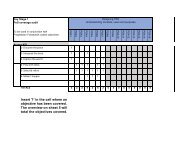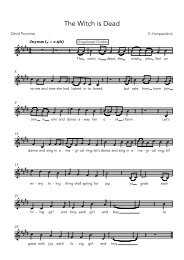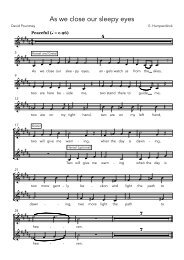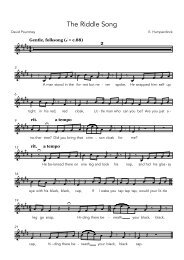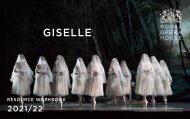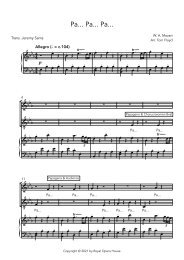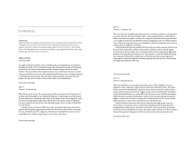You also want an ePaper? Increase the reach of your titles
YUMPU automatically turns print PDFs into web optimized ePapers that Google loves.
THE ROYAL OPERA<br />
LA TRAVIATA<br />
Generously supported by The Taylor Family Foundation and<br />
The Gerald and Gail Ronson Family Foundation<br />
2021/22<br />
RESOURCE WORKBOOK
YOUR VISIT<br />
We are really excited to welcome you and<br />
your students to the Royal Opera House for<br />
the Schools’ Matinee of <strong>La</strong> <strong>traviata</strong> on<br />
Friday 1 April 2022.<br />
Welcome to the Royal Opera House film<br />
This film introduces you and your students to the Royal<br />
Opera House, guiding them through the spaces they will visit,<br />
introducing them to some of the people they will encounter and<br />
some of the exciting things they might see.<br />
Cover, Angel Blue as Violetta Valéry ©2019 ROH. Photograph by Catherine Ashmore. Left,<br />
Production Photo © 2016 ROH. Photograph by Tristram Kenton
THE CHARACTERS<br />
VIOLETTA VALÉRY<br />
A beautiful courtesan, Violetta is the life and soul<br />
of the party and has many admirers. She hides a<br />
terrible secret: she is gravely ill and doesn’t know<br />
how much longer she will be able to enjoy her<br />
glittering life in Paris.<br />
ALFREDO GERMONT<br />
Alfredo is young and ready to experience love for<br />
the first time. He has fallen for Violetta and visits her<br />
every day while she is ill. He wants to build a new life<br />
with Violetta in the countryside.<br />
GIORGIO GERMONT<br />
Alfredo’s father loves his son and is concerned about<br />
his relationship with Violetta. He wants to protect the<br />
reputation of his family and tries to convince Violetta<br />
to leave Alfredo.<br />
Angel Blue as Violetta Valéry, Liparit Avetisyan as Alfredo Germont, Igor Golovatenko as Giorgio Germont ©2019 ROH. Photographs by Catherine Ashmore
THE CHARACTERS<br />
ANNINA<br />
Violetta’s faithful maid, she moves with her and<br />
Alfredo to the countryside and takes care of the<br />
household. She also looks after Violetta when she is<br />
sick.<br />
BARON DOUPHOL<br />
The Baron is a powerful man who supports Violetta<br />
in exchange for her company. When Violetta is<br />
convinced by Giorgio Germont to leave Alfredo, she<br />
turns to the Baron. This angers Alfredo, and he and<br />
the Baron fight a duel.<br />
FLORA BERVOIX<br />
Flora is Violetta’s friend and is also a hostess in<br />
Paris. She hosts the gambling party where Alfredo<br />
discovers that Violetta has left him for the Baron.<br />
Renata Skarelytë as Annina ©2021 ROH. Photograph by Tristram Kenton<br />
Germán E. Alcántara as Baron Douphol ©2019 ROH. Photograph by Catherine Ashmore<br />
Stephanie Wake-Edwards as Flora Bervoix ©2019 ROH. Photograph by Catherine Ashmore
THE STORY<br />
ACT I<br />
A salon in Violetta’s house; August<br />
Violetta greets her party guests. Gastone, a viscount,<br />
introduces his friend Alfredo Germont to Violetta and tells<br />
her that Alfredo thinks of her constantly and called on her<br />
anxiously each day during her recent illness. Baron Douphol,<br />
Violetta’s current lover, waits nearby to escort her to the<br />
salon. Gastone, seconded by Violetta, calls for a toast. Alfredo<br />
responds with a song in praise of wine and pleasure, and<br />
everyone joins in.<br />
Violetta invites her guests to dance but suddenly feels<br />
unsteady and tells the others to go on without her. Alfredo<br />
stays behind; he warns her that her present way of life will kill<br />
her. He offers to look after her, admitting that he has loved<br />
her since he first saw her over a year ago. Violetta replies<br />
lightheartedly that she does not know how to love: he should<br />
forget her. She gives him a camellia, telling him to return it<br />
to her when it has faded; hoping that will be the next day,<br />
he leaves, saying that he loves her. As dawn approaches, the<br />
other guests depart.<br />
Alone, Violetta reflects on Alfredo’s unexpected declaration of<br />
love and on her feelings for him, then abandons such serious<br />
thoughts, recalling that she is destined for a life of pleasure.<br />
Hrachuhi Bassenz as Violetta Valéry ©2019 ROH. Photograph by Catherine Ashmore
ACT II, SCENE 1<br />
A country house near Paris; the following January<br />
Alfredo and Violetta have spent three idyllic months in the<br />
country, but Alfredo doesn’t know that Violetta has been selling<br />
her belongings to pay for their life together. When he realises this,<br />
Alfredo resolves to leave for Paris and raise the money himself.<br />
While he is gone, Giorgio Germont (Alfredo’s father) arrives<br />
unannounced and accuses Violetta of ruining his son. He is<br />
shocked to discover that it is in fact she who is supporting the<br />
couple. He then tells her of the plight of his beloved daughter,<br />
whose forthcoming marriage is jeopardized by Alfredo’s<br />
scandalous liaison with Violetta and begs Violetta to leave Alfredo<br />
so that he can return to his family. Violetta confesses to Germont<br />
her overwhelming love, revealing the seriousness of her illness<br />
and her emotional dependence on Alfredo. Germont is unmoved<br />
and says she is bound to find other men to love. Grief-stricken,<br />
Violetta finally agrees to make the sacrifice, asking Germont to<br />
embrace her as his daughter and to comfort Alfredo when she<br />
has gone. After she dies, she wants Germont to tell Alfredo the<br />
real reason for her leaving him. Germont goes.<br />
When Alfredo returns from Paris, he is disturbed at Violetta’s<br />
agitated state and concerned that his father should have visited.<br />
Violetta, now in despair at her promise, wants reassurance of<br />
Alfredo’s love for her before she runs away. Germont appears<br />
again and tries to comfort his son, reminding him nostalgically<br />
of his family home in the south of France. But Alfredo is<br />
inconsolable. Seeing an invitation to a party at Flora’s that<br />
evening, he assumes Violetta will be there, and swears to avenge<br />
himself.<br />
Saimir Pirgu as Alfredo Germont Opera © 2016 ROH. Photograph by Tristram Kenton
ACT II, SCENE 2<br />
A salon in Flora’s house<br />
Flora’s guests chat and gamble at her party. She and her new<br />
lover discuss the separation of Alfredo and Violetta. A group<br />
of guests sing and dance, followed by Gastone and friends<br />
disguised as matadors.<br />
Alfredo arrives and joins a game of cards, playing recklessly<br />
and commenting that his luck at the table is better than his<br />
fortune in love. He feigns disinterest at seeing Violetta with<br />
Baron Douphol but provokes the Baron into challenging him at<br />
cards. While Violetta privately expresses her anguish, the two<br />
men gamble. The Baron loses, swearing revenge, and everyone<br />
goes off to supper. Violetta returns, having sent Alfredo a<br />
message asking him to join her. When he appears, she begs him<br />
to escape from the Baron’s wrath and he agrees to leave if she<br />
swears to follow him. Remembering her oath to Germont, she<br />
lies and tells Alfredo that she cannot go with him because she<br />
now loves the Baron. In fury, Alfredo summons the guests and,<br />
flinging his winnings at Violetta, asks everyone to witness that<br />
he has paid her back for their time together. The guests rebuke<br />
Alfredo, and Germont, who has arrived unobserved, renounces<br />
his son. Everyone expresses their reactions to the situation:<br />
Germont is reproachful; Alfredo is distressed and remorseful;<br />
Violetta, despairingly and privately, begs Alfredo to understand<br />
her distress, vowing her undying love for him; the Baron swears<br />
to avenge the insult to Violetta.<br />
Production photo ©2021 ROH. Photograph by Tristram Kenton
ACT III<br />
Violetta’s bedroom; February<br />
Violetta is desperately ill and is being nursed by Annina. Doctor<br />
Grenvil visits and offers her encouragement but quietly tells<br />
Annina that Violetta has only a few hours to live. Violetta urges<br />
Annina to join the Carnival festivities outside and to take half of<br />
Violetta’s money to give to the poor.<br />
Alone, Violetta reads a letter from Germont explaining that<br />
Alfredo, who fled the country after wounding the Baron in a<br />
duel, now knows of her sacrifice and is coming to beg her to<br />
pardon him. Violetta knows that all hope for her has faded and<br />
says farewell to past dreams, praying for God’s forgiveness.<br />
The Carnival can be heard outside. Annina hurries in to tell<br />
Violetta of Alfredo’s approach. He falls into her arms, imploring<br />
her to forgive him and his father.<br />
They plan a new life, away from Paris, but Violetta is now too<br />
weak to get up. In despair that she will die so young, Violetta<br />
briefly rallies. Giorgio Germont appears and embraces her.<br />
Violetta gives Alfredo a locket containing her portrait, telling<br />
him that if he marries, he must give it to his bride. Violetta feels<br />
a sudden rush of life as her pain eases. But she collapses and<br />
dies.<br />
Ekaterina Bakanova as Violetta Valéry ©2017 ROH. Photograph by Tristram Kenton
CONTENT WARNING<br />
Although <strong>La</strong> <strong>traviata</strong> (literally, ‘the fallen woman’) is one of the most<br />
popular works in the operatic repertory, the story deals with some issues<br />
that you may want to explain and discuss with your students ahead of<br />
their visit.<br />
The heroine of the opera, Violetta Valéry, is a courtesan. Courtesans<br />
were women, often led into prostitution from an early age, who rose in<br />
prominence as mistresses of wealthy and influential men through the<br />
power of their beauty, charisma and intelligence.<br />
In a patriarchal, religious society in which options for women were very<br />
limited, courtesans were not considered ‘respectable’. They were excluded<br />
from ‘polite’ society, and instead occupied a demi monde (literally, ‘halfworld’).<br />
However, some courtesans managed to amass large personal<br />
fortunes and set themselves up independently, becoming leaders in taste,<br />
fashion and political and intellectual discourse.<br />
In Act II of the opera, Alfredo’s father Giorgio Germont visits Violetta in<br />
the house she has been sharing with Alfredo, unaware that it is actually<br />
Violetta who has been paying for their lifestyle. He demands that Violetta<br />
leave Alfredo, fearing that his association with a courtesan will tarnish the<br />
reputation of his family and bring shame on Alfredo’s sister, who is about<br />
to make a respectable bourgeois marriage. The story revolves around the<br />
sacrifice Violetta feels she must make for Alfredo. Violetta is also dying of<br />
consumption (tuberculosis) and chooses to make her sacrifice even in the<br />
knowledge that her time with Alfredo is limited.<br />
Of the many reasons for the enduring success of <strong>La</strong> <strong>traviata</strong>, not least<br />
is the humanity with which composer Giuseppe Verdi and librettist<br />
Francesco Maria Piave portray the lead role. Violetta, far from being a<br />
shameful person, lives her life with compassion, integrity and agency, even<br />
when the odds are stacked against her.<br />
Maria Agresta as Violetta Valéry ©2016 ROH. Photograph by Tristram Kenton
THE COMPOSER<br />
GIUSEPPE VERDI (1813–1901)<br />
Giuseppe Verdi was an Italian composer. Of his<br />
26 operas, many remain among the most loved<br />
and frequently performed in the repertory.<br />
Verdi began his professional career as the local<br />
church organist at the early age of eight. By his<br />
mid-twenties, he was conducting the Busseto<br />
Philharmonic Society, attracting praise for his<br />
promising musical imagination and his skill as a<br />
conductor and composer.<br />
Among his early works, the opera Nabucco<br />
provided Verdi with international fame and<br />
recognition. However, the pressure to keep<br />
producing commercially and critically successful<br />
work left the composer often feeling<br />
demoralised.<br />
Verdi’s first wife Margherita and their two<br />
children all died tragically young. Verdi adored<br />
them and was devastated by their deaths. He<br />
found love again, however, with the noted<br />
soprano Giuseppina Strepponi. They lived<br />
together unmarried for over 15 years, causing<br />
much scandal, although they eventually married<br />
in 1859.<br />
Financial success allowed Verdi, in his later years,<br />
to undertake a number of philanthropic ventures.<br />
He published a song in 1894 for the benefit of<br />
earthquake victims in Sicily, and from 1895<br />
onwards he endowed a rest-home for retired<br />
musicians in Milan and built a hospital close to<br />
Busseto. He died in 1901 at the age of 87.<br />
TIMELINE<br />
1813 Giuseppe Verdi is born near Busseto,<br />
Italy.<br />
1823 Aged 10, Verdi attends school in<br />
Busseto, returning on Sundays to play the<br />
organ.<br />
1839 Verdi’s first opera, Oberto, is performed<br />
at the Teatro alla Scala, Milan.<br />
1851 Verdi moves to Paris with soprano<br />
Giuseppina Strepponi. While in Paris, the<br />
couple attend a performance of the play <strong>La</strong><br />
Dame aux camélias, on which the opera <strong>La</strong><br />
<strong>traviata</strong> is based.<br />
1859 Verdi begins to take an active interest<br />
in Italian politics (sympathising with the<br />
Risorgimento movement that sought Italian<br />
unification) and is eventually appointed as a<br />
member of the Italian Senate in 1874.<br />
1901 Verdi dies. He remains one of the most<br />
important and popular composers of opera.
POST PERFORMANCE REFLECTIONS<br />
These questions can be used to prompt<br />
your students after the performance.<br />
Consider the life of women in 19th century<br />
Paris and the choices they were faced<br />
with. What might the life of a courtesan be<br />
like?<br />
What do the design choices tell you about<br />
the story and the characters? Consider the<br />
set and costumes, how are the different<br />
parts of the story portrayed?<br />
Reputation and image play a big part in<br />
this story, are there modern day examples<br />
which you could use to compare and<br />
contrast the actions of the characters?<br />
<strong>La</strong> <strong>traviata</strong> is one of the most performed<br />
operas in the world – what do you think<br />
makes it so well loved? What makes<br />
Violetta such a popular part for sopranos?<br />
Luca Salsi as Alfredo Germont and Venera Gimadieva as Violetta<br />
Valéry ©2016 ROH. Photograph by Tristram Kenton
FURTHER VIEWING<br />
3:21 3:07<br />
1:31:42<br />
THE ENDURING APPEAL OF LA TRAVIATA<br />
Director Richard Eyre and designer<br />
Bob Crowley discuss the genesis of The<br />
Royal Opera’s production of <strong>La</strong> <strong>traviata</strong>.<br />
LA TRAVIATA: HOW TO PERFORM AN<br />
OPERATIC ICON<br />
Soprano Corinne Winters discusses what<br />
it’s like to sing the iconic role of<br />
Violetta Valéry.<br />
HOW TO SING OPERA – ANGEL BLUE<br />
VOCAL MASTERCLASS (THE ROYAL<br />
OPERA)<br />
Soprano Angel Blue (who sings the role of<br />
Violetta in <strong>La</strong> <strong>traviata</strong>) gives a master class<br />
to young singers from The Royal Opera’s<br />
Jette Parker Young Artist Programme.<br />
The Royal Opera House YouTube channel has many more performance clips and behind the scenes videos that you can explore. Find more videos here:<br />
www.youtube.com/c/RoyalOperaHouse<br />
Angel Blue as Violetta Valéry and Benjamin Bernheim as Alfredo Germont ©2019 ROH. Photograph by Catherine Ashmore, Corinne Winters as Violetta Valéry ©2017 ROH. Photograph by Tristram Kenton, Angel Blue as<br />
Violetta Valéry ©2019 ROH. Photograph by Catherine Ashmore
CREATE AND LEARN<br />
We place creative learning at the centre of children’s education,<br />
through certified CPD and online programmes, opening a<br />
window into the world of ballet, opera and theatrecraft.<br />
Our <strong>resource</strong>s, created together with teachers in schools across<br />
the UK:<br />
• Build teachers’ confidence, providing the tools to facilitate<br />
learning through the arts. No previous experience required.<br />
• Develop students’ creativity, resilience, communication and<br />
and other transferable skills.<br />
• Are relevant to current school topics, providing a theme for<br />
cross-curricular work and a springboard for literacy.<br />
WE OFFER:<br />
• Practical training for KS1 to KS5 teachers country-wide.<br />
• Free <strong>digital</strong> <strong>resource</strong>s offering two-lesson (Taster), five-lesson<br />
(Explorer) and ten-lesson (Immersive) schemes of work.<br />
• Introductory films that inspire and entertain students,<br />
reinforcing the activities and concepts they encounter in the<br />
lessons.<br />
• Programmes schools can use to suppor their ArtsMark<br />
journey. Arts Award Explore or Discover <strong>resource</strong>s also available.
CREATE & DANCE<br />
createanddance@roh.org.uk<br />
KS1 to KS3<br />
This programme provides an understanding of dance by<br />
unlocking children’s imaginations and creativity.<br />
CREATE & SING<br />
createandsing@roh.org.uk<br />
KS1 to KS3<br />
This programme develops skills in singing, drama, storytelling,<br />
characterization and music.<br />
CREATE & DESIGN<br />
createanddesign@roh.org.uk<br />
KS1 to KS3<br />
Develop an understanding of stage design and follow a brief<br />
to design sets for a ballet.<br />
DESIGN CHALLENGE<br />
design.challenge@roh.org.uk<br />
KS4 to FE/HE<br />
In this annual competition students build a portfolio and<br />
understand creative career pathways.<br />
CREATE & LEARN<br />
For more information on all of our programmes<br />
visit: learning-platorm.roh.org.uk





